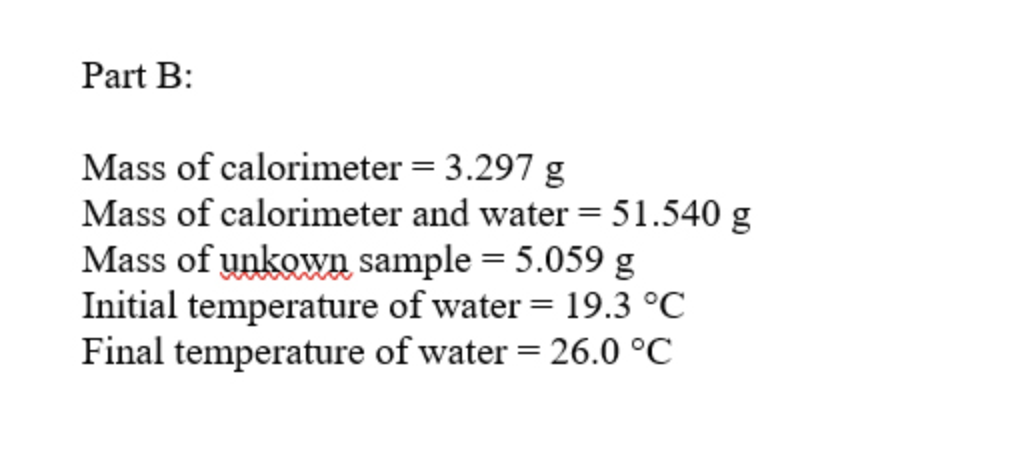
Chemistry
10th Edition
ISBN: 9781305957404
Author: Steven S. Zumdahl, Susan A. Zumdahl, Donald J. DeCoste
Publisher: Cengage Learning
expand_more
expand_more
format_list_bulleted
Concept explainers
Question
What is the mass of the water used?
What is the total mass of the solution? (water+salt)
What is the temperature change of the solution? Remember to use the correct sign of delta T. A temperature increase is positive. A temperature decrease is negative.
Calculate the energy absorbed or released by the solution using the temperature change calculated. Use the mass of water plus solid. Assume the same specific heat as water (4.18J/gC). Use the correct sign for q (same sign as the temperature change).
Using the answer above and the mass of unknown, calculate the enthalpy of solution per gram for the unknown? Be sure to use the correct sign.

Transcribed Image Text:Part B:
Mass of calorimeter = 3.297 g
Mass of calorimeter and water = 51.540 g
Mass of unkown sample = 5.059 g
Initial temperature of water = 19.3 °C
Final temperature of water = 26.0 °C
Expert Solution
This question has been solved!
Explore an expertly crafted, step-by-step solution for a thorough understanding of key concepts.
This is a popular solution
Trending nowThis is a popular solution!
Step by stepSolved in 5 steps with 3 images

Knowledge Booster
Learn more about
Need a deep-dive on the concept behind this application? Look no further. Learn more about this topic, chemistry and related others by exploring similar questions and additional content below.Similar questions
- What would the effect on the specific heat of your metal if one drop (0.05mL) of water at 100 degrees Celsius remained on your metal? the effect would cause the specific heat to be much higher none of these choices are correct the effect would cause the specific heat to be much lower the effect would be negligible Oarrow_forwardHow much would the temperature (in K) of 770 g of ethanol increase if 24.5 kJ of heat were added?arrow_forwardPlease help me complete this questionarrow_forward
- Specific Heats of Substances Substance Specific Heat g-°C Brick 0.20 Ethanol 0.58 0.10 pooM Calculate the amount of heat, in calories, that must be added to warm 70.9 g of brick from 19.3 °C to 41.0 °C. Assume no changes in state occur during this change in temperature. heat added: cal Calculate the amount of heat, in calories, that must be added to warm 70.9 g of ethanol from 19.3 °C to 41.0 °C. Assume no changes in state occur during this change in temperature. heat added: calarrow_forward3.56 g of MgSO₄ is placed into 100.0 mL of water. The water's temperature increases by 6.70 °C. Calculate ∆H, in kJ/mol, for the dissolution of MgSO₄. (The specific heat of water is 4.184 J/g・ °C and the density of the water is 1.00 g/mL). You can assume that the specific heat of the solution is the same as that of water.arrow_forwardA total of 2.00 mol of a compound is allowed to react with water in a foam coffee cup and the reaction produces 156 g of solution. The reaction caused the temperature of the solution to rise from 21.00 to 24.70 degrees Celsius. What is the enthalpy of this reaction? Assume that no heat is lost to the surroundings or to the coffee cup itself and that the specific heat of the solution is the same as that of pure water. Enter your answer in kilojoules per mole of compound to three significant figures.arrow_forward
- 3.15 mol of an unknown solid is placed into enough water to make 150.0 mL of solution. The solution's temperature increases by 11.81°C. Calculate ∆H, in kJ/mol, for the dissolution of the unknown solid. (The specific heat of the solution is 4.184 J/g・°C and the density of the solution is 1.20 g/mL).arrow_forwardcalculate the amount of heat released by 23.0g of water when its temperature is cooled from 68.0'C to 31.0'C. the specific heat of water is 4.18 j/g'carrow_forward
arrow_back_ios
arrow_forward_ios
Recommended textbooks for you
 ChemistryChemistryISBN:9781305957404Author:Steven S. Zumdahl, Susan A. Zumdahl, Donald J. DeCostePublisher:Cengage Learning
ChemistryChemistryISBN:9781305957404Author:Steven S. Zumdahl, Susan A. Zumdahl, Donald J. DeCostePublisher:Cengage Learning ChemistryChemistryISBN:9781259911156Author:Raymond Chang Dr., Jason Overby ProfessorPublisher:McGraw-Hill Education
ChemistryChemistryISBN:9781259911156Author:Raymond Chang Dr., Jason Overby ProfessorPublisher:McGraw-Hill Education Principles of Instrumental AnalysisChemistryISBN:9781305577213Author:Douglas A. Skoog, F. James Holler, Stanley R. CrouchPublisher:Cengage Learning
Principles of Instrumental AnalysisChemistryISBN:9781305577213Author:Douglas A. Skoog, F. James Holler, Stanley R. CrouchPublisher:Cengage Learning Organic ChemistryChemistryISBN:9780078021558Author:Janice Gorzynski Smith Dr.Publisher:McGraw-Hill Education
Organic ChemistryChemistryISBN:9780078021558Author:Janice Gorzynski Smith Dr.Publisher:McGraw-Hill Education Chemistry: Principles and ReactionsChemistryISBN:9781305079373Author:William L. Masterton, Cecile N. HurleyPublisher:Cengage Learning
Chemistry: Principles and ReactionsChemistryISBN:9781305079373Author:William L. Masterton, Cecile N. HurleyPublisher:Cengage Learning Elementary Principles of Chemical Processes, Bind...ChemistryISBN:9781118431221Author:Richard M. Felder, Ronald W. Rousseau, Lisa G. BullardPublisher:WILEY
Elementary Principles of Chemical Processes, Bind...ChemistryISBN:9781118431221Author:Richard M. Felder, Ronald W. Rousseau, Lisa G. BullardPublisher:WILEY

Chemistry
Chemistry
ISBN:9781305957404
Author:Steven S. Zumdahl, Susan A. Zumdahl, Donald J. DeCoste
Publisher:Cengage Learning

Chemistry
Chemistry
ISBN:9781259911156
Author:Raymond Chang Dr., Jason Overby Professor
Publisher:McGraw-Hill Education

Principles of Instrumental Analysis
Chemistry
ISBN:9781305577213
Author:Douglas A. Skoog, F. James Holler, Stanley R. Crouch
Publisher:Cengage Learning

Organic Chemistry
Chemistry
ISBN:9780078021558
Author:Janice Gorzynski Smith Dr.
Publisher:McGraw-Hill Education

Chemistry: Principles and Reactions
Chemistry
ISBN:9781305079373
Author:William L. Masterton, Cecile N. Hurley
Publisher:Cengage Learning

Elementary Principles of Chemical Processes, Bind...
Chemistry
ISBN:9781118431221
Author:Richard M. Felder, Ronald W. Rousseau, Lisa G. Bullard
Publisher:WILEY